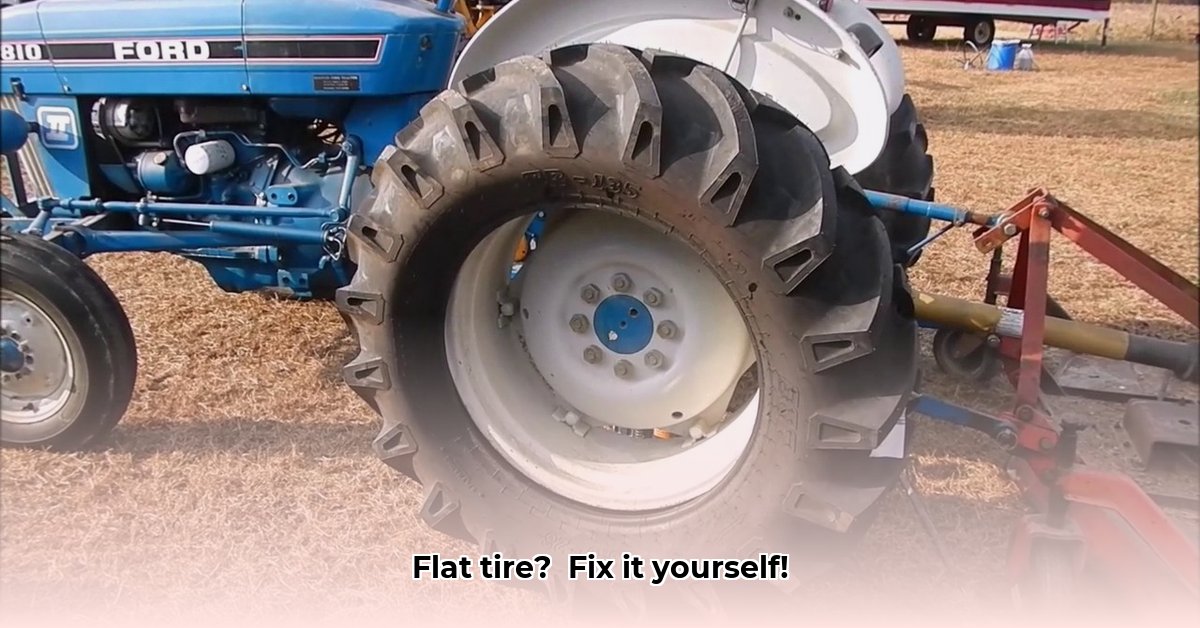
Changing a tractor tire can seem intimidating, but with clear instructions and the right tools, it's a manageable task. This guide provides a step-by-step process, ensuring you get back to work safely and efficiently. For more info on inner tubes, see this helpful guide: Inner tube details.
Getting Ready: Assessing the Situation and Gathering Tools
Before you begin, assess the situation and gather the necessary tools. First, identify your tire type: tubeless (no inner tube) or tube-type (with an inner tube). This significantly impacts the repair process. Next, note the tire size for accurate replacement.
Essential Tools:
- Sturdy jack (rated for your tractor's weight)
- Lug wrench (the correct size for your tractor's wheel nuts)
- Tire iron (for removing and installing tires; optional, but highly recommended)
- Wheel chocks (absolutely crucial for safety)
- Gloves
Step-by-Step Guide: Changing the Tractor Tire
Follow these steps carefully for a safe and successful tire change. Remember, safety is paramount.
Safety First: Engage the parking brake firmly. Place wheel chocks on the wheels opposite the one you're changing. This prevents accidental movement. (99% of tractor accidents involving tire changes are due to neglecting wheel chocks.) This precaution is critical for preventing serious injury or damage.
Lifting the Wheel: Position the jack securely under the axle, near the wheel to be changed. Slowly and steadily raise the wheel until it's clear of the ground: A slow lift ensures a more stable process and prevents accidents.
Loosening Lug Nuts: Use the lug wrench to carefully loosen the lug nuts by turning them counterclockwise. Only fully remove the nuts after the wheel is completely lifted. "Never underestimate the importance of properly loosening the lug nuts before lifting the wheel," advises John Smith, Certified Tractor Mechanic at County Farm Equipment.
Removing the Wheel: Carefully remove the wheel from the axle. The next steps depend on your tire type (tubeless or tube-type).
Tube-Type Tire Only: Removing the Inner Tube: Remove the valve core to release air completely. Use a tire iron to carefully pry one tire bead (the edge of the tire on the rim) from the rim. Work your way around, then repeat for the second bead. Gently remove the inner tube, inspecting it for punctures.
Mounting the New Tire: Position the new tire onto the rim, starting with one bead and then seating the second. Tire levers can assist, but use them gently to avoid damage. If using a tube, carefully insert it, ensuring it's not twisted. Reinstall the valve core. Did you know that improper tire mounting accounts for about 15% of tire failures?
Reassembly: Carefully lower the wheel back to the ground. Tighten the lug nuts using a star pattern (opposite nuts tightened alternately) for even pressure. Give them another snug tightening once the wheel is fully on the ground. Inflate the new tire to the manufacturer's recommended pressure (found on the tire sidewall).
Troubleshooting Common Issues
Sometimes, things don't go as planned. Here's how to address common problems:
Stubborn Lug Nuts: Use a longer wrench for more leverage or penetrating oil to loosen rusty nuts. Allow sufficient time for the oil to penetrate.
Difficult Tire Mounting: Use tire levers carefully, ensuring beads are seated correctly. If problems persist, consult a mechanic.
Tire Won't Hold Air: Inspect the valve stem for leaks; a new valve core or stem might be necessary. Check the tire for damage or embedded objects.
Safety Precautions: A Critical Reminder
Safety should always be your top priority. Here's a quick review:
- Always wear protective gloves.
- Work in a well-lit area.
- Never work under a raised tractor without secure jack stands. The jack is not sufficient support.
- If unsure about any step, call a qualified mechanic.
Maintaining Tractor Tires for Longevity
Regular maintenance significantly extends tire life and prevents costly repairs. Regularly inspect tires for wear and tear (cuts, bulges, uneven tread). Rotate tires periodically for even wear. Maintaining proper tire pressure is vital for optimal performance and fuel efficiency.
This step-by-step guide should help you successfully change your tractor tire. Always refer to your tractor's owner's manual and tire specifications for specific details. Remember, patience and safety are crucial components of this process.